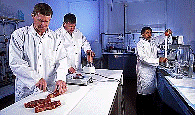United States Department of Agriculture: Agricultural Research Service, Lincoln, Nebraska

Roman L. Hruska U.S. Meat Animal Research Center: Reports
Date of this Version
1993
Document Type
Article
Abstract
Feedstuffs are degraded in the rumen, providing energy and nutrients for microbial growth. Volatile fatty acids produced during this process are absorbed and used as an energy source by the animal. The bacteria that are produced and unfermented feed residue flow out of the rumen to the small intestine where further digestion and absorption occurs. Of the total protein flowing to the small intestine, 50 to 90% is microbial protein. It is of high quality, well digested and well used by the animal.
Currently, estimates of the amount of microbial protein synthesized in the rumen vary considerably. We do not understand what portion of this variation can be attributed to nutritional factors such as feed intake, forage versus grain, animal differences, etc. Because the amino acid profile of dietary ingredients and ruminal microflora differ, knowing what influences the amount and proportion of each flowing to the lower gut is very important if we are going to extend our understanding of protein utilization in cattle.
The amount of microbial protein flowing to the small intestine in cattle is measured in the following manner: 1) cattle are surgically fitted with a ruminal and duodenal cannula for digesta sampling; 2) After a dietary adjustment period, ruminal bacteria are harvested and duodenal (anterior small intestine) digesta is sampled; 3) Laboratory analyses are conducted and the amount of microbial protein flowing at the duodenum is determined. Dietary protein flow at the small intestine is calculated as the difference between total protein flow and microbial protein flow.
This approach has been used by researchers for several years, but it may have limitations. First, it is unable to account for endogenous nitrogen flowing at the duodenum, due to either sloughed cells or abomasal secretions. Any endogenous nitrogen would overestimate the flow of dietary protein. Secondly, it is assumed that a sample of bacteria obtained from the rumen represents bacteria flowing out of the rumen. If this assumption is not correct, then our estimate on the amount of microbial protein flowing at the duodenum is not correct.
The potential limitations in research techniques might account for the large variation in the amount of microbial protein synthesized. These limitations might be overcome if a different cannulation technique were employed so we could sample digesta flowing out of the rumen. To our knowledge, this approach has been used in sheep by four different investigators with limited success. Building on the reported limitations of these efforts in sheep, we wanted to conduct a similar surgical preparation in cattle. We had two objectives, 1) determine if nitrogen flowing out of the rumen differed from nitrogen flow at the duodenum, and 2) determine if the composition of bacteria in the rumen differed from bacteria flowing out of the rumen.


Comments
Published in Beef Research Program Progress Report (1993) No. 4 (Part 1): 114-115